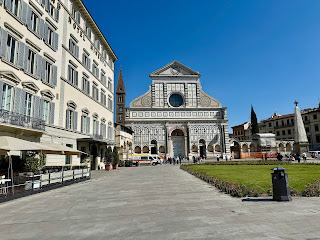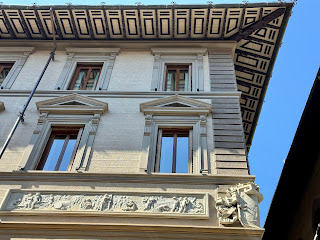Firenze (pop 362,353 in 2025) is an easy train ride from Bologna, and we are meeting family there for a quick look. We are familiar with so many significant and historic sites, but there are young children and crowded streets involved, so we are unsure how the day will go.
We arrive at the stazione behind the Basilica di Santa Maria Novella (15th century; facade, Leon Battista Alberti, 1470). The Basilica is part of the Convento Domenicano, so its members follow San Domenico di Guzmán; this must be his portrait in the tympanum, below the Stemma Rucellai.
In the Piazza Santa Maria Novella, while pointing out the Obelisco and the Campanile. we get our bearings and make a general plan. To get the kids off to a good start, we head to the Piazza della Repubblica and its giostra a carosello (with scenes of the city on the fascia).
From Repubblica, we make our way to the Mercato Nuovo ('Mercato del Porcellino') The kids enjoy shopping for souvenirs and watching other tourists rubbing the pig's nose. The perfect late-morning weather drives us onward to the Ponte Vecchio. From the railing, we enjoy the glorious views and reflections of the city. Much easier than walking to the Piazzale Michelangelo, from here we may point out all the famous sites and get a lay of the land.
We double-back to the Piazza della Signoria, with the Loggia dei Lanzi, the Palazzo Vecchio (top image, 14th century), and Michelangelo's David (1501-04). The Piazza' s history and artworks still amaze.
From there, we head east, toward the Bargello, and enter the Piazza del Duomo near the south transept. Deliberately, we walk to the front of the Cattedrale di Santa Maria del Fiore ('Duomo di Firenze', 13th-15th centuries), marveling at the patterns and sculptures.
We all sit down to an enormous Fiorentino lunch; the kids are served first and have time to take a nap. We finish the day shopping around the Mercato Centrale and Orsanmichele, before relaxing in Repubblica with cold drinks and gelato.

















































